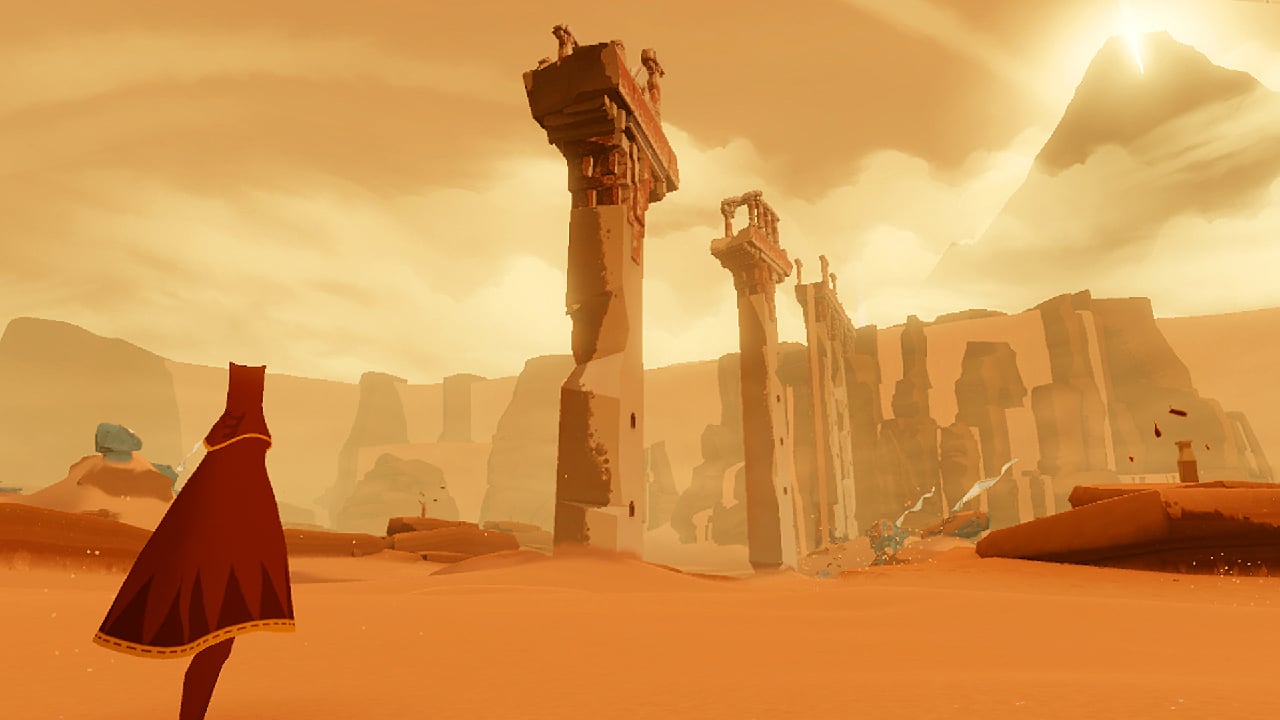
Playing Journey is a bit like sliding through an exotic dream. It’s exhilarating one moment, sad the next, and, inherently, the experience is solely yours, the dreamer’s. The intensity of such things, for better or worse, will always fade when you leave the bed or put down the controller. The sights and sounds evaporate in daylight, and the experience boils away to lingering, naked emotion. When someone asks if you had any dreams last night, you’re at a loss for words. But you have no lack of feelings, difficult though they are to convey.
I played through Journey on a cold night in March, but the memory went dormant until a few days ago. It was one of those nervous, gleeful moments that come up every so often for any hobbyist or closeted geek: A friend of mine, with whom I quite happily spend time never mentioning games, was asking about them. My mind raced – I don’t make a habit of talking about this kind of thing, but I jump like a hungry dog when I get a good chance. With effort, I held myself back from clicking open my metaphorical briefcase and unleashing an off-putting presentation of why games will save the world, or some other overwrought bullshit. Luckily, I managed to keep my head on straight and give a sensible, not-too-enthusiastic account of what makes games worth playing – or at least, I hope I did. I was mostly satisfied when the conversation moved on, if only because I didn’t embarrass myself, and she didn’t think any worse of games. Mostly satisfied, but not entirely.
In the rapid scanning of my mental archives, Journey was the first hit in response to the query, “Which games are interesting to non-gamers?” Even so, the Journey page in my mind was gibberish. The problem, I’ve realized, is that Journey escapes conventional description. It’s not a platformer, it’s not a puzzler and it’s certainly not an action game. Its title reveals nothing about the game. There’s no dialogue, no clear story, no names, no specific setting, no bosses, no checkpoints, no life bars, no skill trees and no death. It’s deeply subjective, mingling in the curious spaces where joy, sorrow, loss and anger meet. At times it flies; at others it falls. It’s dynamism; it’s despair.
It’s emotion, in motion.
Ah, yes – that sense of movement. I could never properly capture it without putting a controller in your hands. Likewise, I’ve never seen a game accomplish so much with the plain action of pushing a joystick forward. You feel exhausted trudging through the sand, then elated as you ski down the opposite slope, riding the winds as they twirl your scarf and tug at your robes. Your strength later fades as the elements claim you; a blizzard closes in, your legs grow heavy. With an earnest, caring focus, you push a bit harder on the joystick – but to no avail. One knee falls, then you collapse. After that comes the game’s best use of motion, which I won’t spoil. It’s eye-opening, really, for a single gameplay mechanic to move you through all the emotional peaks and valleys of a stirring concerto.
I wondered for some time how such a simple game could pull so fiercely at my heartstrings. It’s precisely that austerity, though, that makes Journey so provocative. It reduces the explicit experience to basic, sub-cortical reactions, stripping us bare and letting us bring our own emotionality to the table. For that reason I came to think of Journey as really knowing me as a person – a ridiculous notion, of course, but one that’s grounded in the game’s design.
Journey never holds your hand. It doesn’t put a marker on a map or tell you to go anywhere, and it forgoes most games’ abrasive reminders to “press square to attack!” Such interruption, after all, would wake the placid dreamer. It merely lets you wander as you will, sweeping you oh-so-gently onto the proper path with a cool breeze here or a sharp ledge there. A mountain beckons in the distance, across the sands. You’ll feel so much more purpose, more weight, from deciding to travel there instead of having the game slap a nav-point on it. In that way, Journey seems to anticipate precisely what you will do without ever making you do it. It never tries to force a reaction out of you, but rather feels like an extension of feelings you already have. It’s a bit like a dream, you might agree.
Journey’s most surreal experience, no doubt, comes from encountering another wanderer. Considering the racist 12-year-olds who plague an average match of Halo, I’d assume that any hint of genuine emotion would be dashed away with the inclusion of multiplayer. But Journey, in its own elegant way, deftly avoids this problem. Players remain nameless and mute, lingering in your game only as long as they desire. You might travel together for a time or move past each other like strangers in a train station. If you cooperate, you’ll build a silent bond. A simple language emerges as you look at one another, walk off a bit and chirp to your companion with the game’s one-button singing mechanic. “Follow me,” you both understand. Inevitably, then, you’ll be stung when they leave your side. There are no rules, no technobabble and certainly no screaming adolescents. It’s just two strangers in a strange land, like innocent children on the same playground. Somehow, Journey solved the problem of fostering real, in-game intimacy by stripping out all the traditional ways that games let us communicate. And it’s beautiful.
Simple as it seems, Journey is a cryptic experience. I doubt if I could ever throw enough words onto the Internet to capture all its subtle nuances. But that mystery belies a compelling, unadorned elegance that anyone with a heart would find moving. In so doing, Journey is a powerful case for games being a unique and engaging medium. Even if I can’t win you over with words on a page, I suggest you pick up a controller and give it a try yourself.
